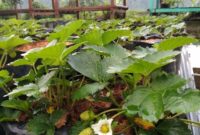There are at least four types of drip systems suitable for typical yards and gardens. They include soaker lines, porous soaker lines, emitter systems, and micromisting systems.
1. Porous Soaker Hose Systems
Porous hoses are easy to handle and are well suited to garden beds, hedges, and rows of shrubs. Porous hose systems can be difficult to install properly in lawns, even by professionals. These drip hoses are made from pressed recycled automobile tires, material that has millions of little air spaces or holes in it. These porous hoses sweat water very slowly along their entire length and are very durable. Such hoses last for 5 to 10 years if kept covered and properly cared for. They are not damaged by freezing, so they can be safely left in the garden all through the winter.
2. Emitter Drip System
The emitter drip system is made up of a series of hoses laid throughout the garden. Each hose has little valves or nozzles (emitters) imbedded in it. These evenly spaced nozzles (12 to 20 inches apart is best), slowly release drops of water into the soil. Emitter systems are particularly good for landscapes with shrubs, such as rose bushes. The emitters can be located so that they drip right into the root zone of the shrub so that you are sure each shrub is getting sufficient water. These systems are also quite durable, but they take more maintenance than do the porous hoses. The emitters can clog up occasionally, but they are easy to replace. To reduce the chances of clogging or other damage, it is best to bring these hoses inside during the winter.

3. Micromisting Sprinklers
Microsprinklers inserted into a drip irrigation hose line produce a mist rather than droplets of water. They were developed for orchards and vineyards but are starting to turn up in backyards. This watering device is a form of drip irrigation which applies water slowly and evenly to the root zone saving water and bringing trees into bearing earlier with increased yields.
- Ideal in flower beds and container plants
- Includes interchangeable spray patterns
- Universal – works with most new or existing drip system
They have special advantages for the ornamental plants in your landscape. For example, the mist keeps the shallow roots of rhododendrons and azaleas cool and moist and gently refreshes the foliage and flowers. The system also protects delicate buds and flowers from frost in spring (the mist must be applied until the temperature rises to 34 degrees).
Microsprinklers are inexpensive – about 40 cost as much as one impact sprinkler. The microsprinklers can be set for varying patterns of coverage and droplet sizes.
